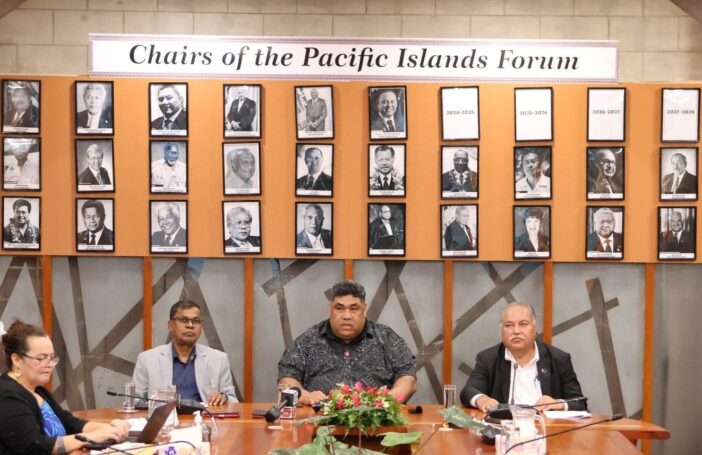The Pacific Plan is the ‘master strategy’ for strengthening regional cooperation and integration in the Pacific, endorsed by Pacific leaders in 2005. Leaders have decided it is time for the Plan to undergo a comprehensive review in 2013. This is Peter Lamour’s submission to that Review (you can still make a submission here).
My view of the Forum and the Plan has mainly been from the outside, but for the last year I have been working at USP, one of the 8 CROP organizations the Plan includes. In earlier work I referred to research that found that ministers and officials who attended regional meetings didn’t follow up on the things they had agreed to.
Here I want to argue that many of the problems of the Pacific Plan are problems of planning itself, and that the review should pay attention to efficiency as well as effectiveness.
At USP I have been helping set up an AusAID-funded centre for Public Administration. From that point of view, implementation, rather than planning, seems to be the main issue facing Pacific Island governments.
Planning itself has costs, in meetings, gathering information and reporting. These costs need to be taken into account in deciding how much planning is enough. For example, recent research reported in ANU’s Development Policy Blog describes how Pacific Islands officials ‘lament being constantly invited to meetings’. According to the researchers
there is a “growing uneasiness, a sense that things are getting out of control”, concerns about high transaction costs and duplication, and the view that good regional governance is, as another interviewee expressed it, “a challenge and a struggle”.
This criticism comes from the medical field, but could also be applied to many other convenors of regional meetings.
What research on Public Administration says about planning
Research on public administration has often been skeptical about the virtues of planning. Among the classics in the field, Charles Lindblom defended ‘the science of muddling through’ as preferable to rational, comprehensive planning. Michael Lipsky found that the plans and policies coming down from central offices were often distractions to ‘street level bureaucrats’ who were busy dealing with their clients’ urgent problems. And Aaron Wildavsky’s study of a job creation scheme in Califormia found the many steps involved in implementation were difficult even in the best of circumstances. His study with Naomi Caiden of ‘Planning and Budgeting in Poor Countries’ described the difficulties of planning even a few months ahead, when revenue streams were so uncertain.
There is also a skeptical tradition in management studies. Mintzberg’s book on Strategic Planning finds the pitfalls of planning include:
- detachment (the isolation of planners from those responsible for delivery)
- excessive formalisation that didn’t take into account managers’ tacit, intuitive or local knowledge, and
- a desire for control, which engenders resistance.
Planning works well for some kinds of repetitive routine tasks, but does less well in creative, professional or innovative work.
It is easy to see some of these pitfalls at work in the aid industry. Donors are detached: they don’t deliver services themselves, but work through local officials. Locals have knowledge that is hard to express in the formal language of planning (particularly if it’s a second language). And planning is often experienced as an imposition from outside.
These pitfalls are also present in the Pacific Plan, which is:
- drawn up by a distinct cadre of specialist officials. ‘Desk officers’ are now being appointed to promote the plan in national capitals’ (source [pdf], p 20). This may only reproduce the detachment, as the desk officers may be treated as a distraction by busy local officials
- formal, abstract and technical in style, and in corporate English (though photographs try and give it a more personal, local and intuitive feel)
- often criticized as an exercise in Australia and New Zealand control, lacking in local ownership. And its language is controlling, referring frequently to what the ‘Leaders’ want, and describing itself as a ‘master’ strategy. No wonder it is resisted.
Criteria for Evaluation
The terms of reference for the review of the Pacific Plan ask the reviewers to report on the impact, effectiveness, appropriateness, influence and ownership of various aspects of the Pacific Plan. The bulk of the Forum’s own progress report [pdf] lists its ‘key achievements’, showing its impact, effectiveness and influence on the agendas of other organizations.
It is often hard for regional organizations (which depend on governments to implement decisions) to show that they have achieved anything. It is also hard to evaluate the effectiveness of professional exchanges, which only indirectly affect the performance of individuals. An official may be fired up by a regional conference, but she can’t do anything to implement the new ideas because her boss disagrees, or it is not in the budget.
However, another standard for evaluation, efficiency, doesn’t get a mention. A simple picture of efficiency compares inputs to outputs, and asks if the organization could do more with less. Reviews often require efficiency savings. They also often load the organization with new tasks, when simplification and cutting back are necessary.
But there is another kind of efficiency, related to the idea of opportunity costs. The organization may be busy, successfully achieving its own goals. But could the funds going to it have been better used to realize other, equally important, goals? Government budgets regularly deal with these questions of allocative efficiency. The question then becomes: could the money spent on the Forum, or the Plan, be better spent elsewhere in the region?
More broadly, if Forum or Plan didn’t exist, would they have to be invented? Or could their tasks be carried out by other officials or by other regional organizations? Or at other levels than the region?
If there is a problem in coordinating the activities of the 8 CROP organizations, then perhaps they could be solved more simply, and well enough, by regular meetings of their agency heads (by Skype). The minutes could be published on the web. Does the Plan add much to that?
This blog is a part of a series on the Pacific Plan Review. Other blogs in this series can be found here.
Peter Larmour is Professor of Public Policy and Administration, University of the South Pacific, and an Adjunct Professor at the Crawford School, ANU.
The Aid Buzz, our monthly round-up of Australian aid and development news, would normally be published today, but we have delayed it to incorporate highlights from the AusAID appearance at Senate Estimates: we’re awaiting the Hansard transcript.






Thanks Peter for this post which is thought provoking and also resonates with a number of the issues that were raised during our meeting with the review team yesterday at the USP campus here in Port Vila. I certainly agree that planning can become an end in itself rather than a contribution to achieving the ‘core business’ of any organisation and this is something to be avoided. And if the Pacific Plan is indeed a ‘living document’ then it is susceptible to being killed off but that is not an option as far as this review is concerned. I do see a role for planning but won’t enter into that debate here. It did occur to me last night that maybe what would be of more benefit would be more of a ‘toolkit’ approach (resources, including processes to identify the most cost-effective modalities to be drawn down by national governments or groupings thereof to meet particular needs)- and a recognition of the need for collaborative efforts to be demand driven. E.g. PNA is largely successful because it is driven by those that have a vested interest and those that don’t can just ignore it and focus on something that is more important to them. (I guess I should copy and paste this comment to the website!)